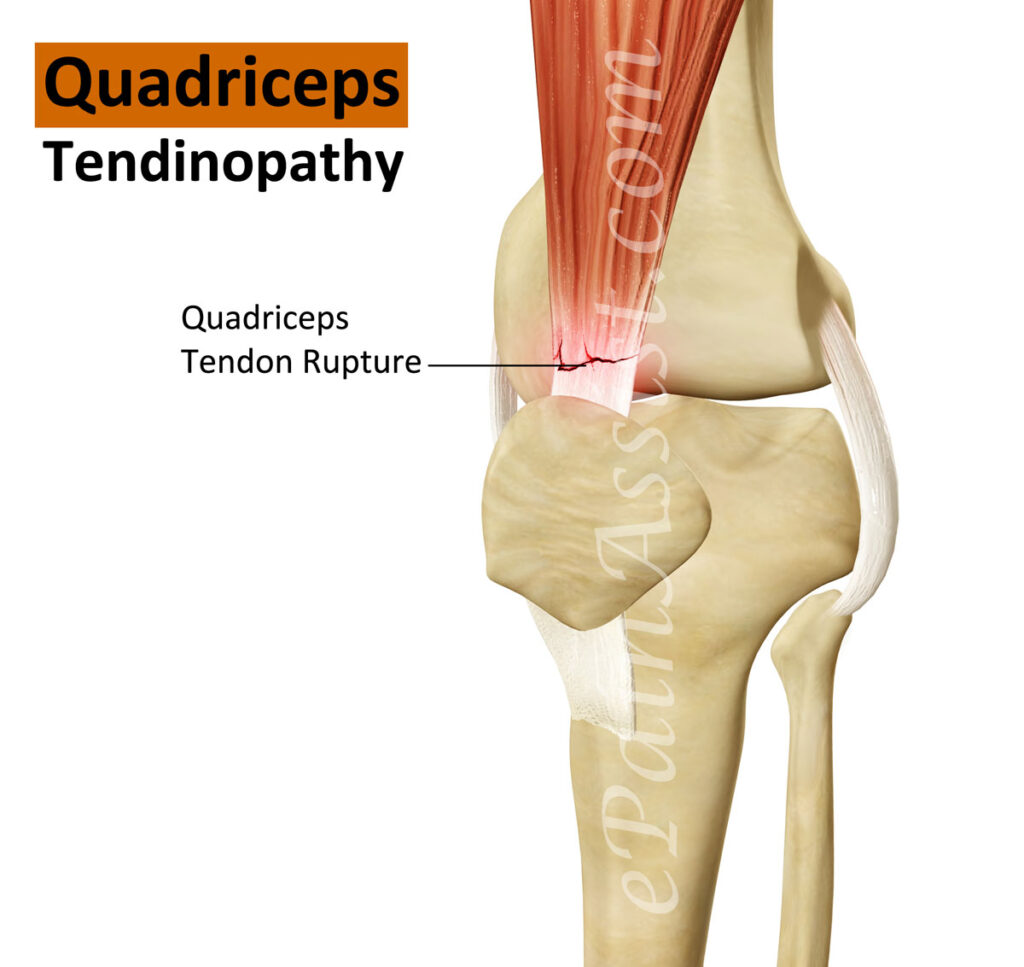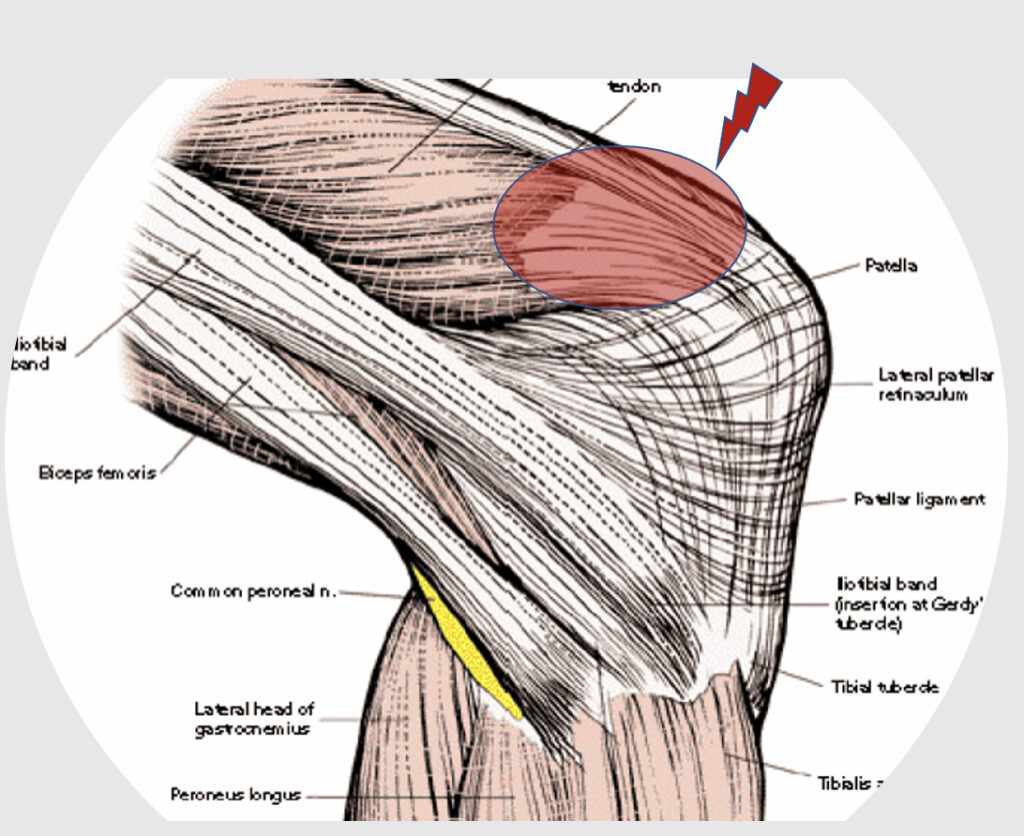Patellar Tendon/ Quad Tendon Tear

Patellar Tendon Tears
If you have injured your patellar tendon, you may be wondering what the next steps are. This comprehensive guide will walk you through everything you need to know about patellar tendon tears, from diagnosis to treatment. You’ll learn about the different types of tears and how they are treated, as well as the potential complications associated with this injury. Armed with this information, you can make the best decisions for your recovery.

What are Patellar Tendon Tears?
Patellar tendon tears are one of the most common knee injuries. The patellar tendon is a strong band of tissue that connects the kneecap (patella) to the shinbone (tibia). A patellar tendon tear can occur when the tendon is overstretched or torn.
The tears can be classified as either partial or complete. A partial tear is a small tear in the tendon that does not completely sever it. A complete tear is a more serious injury that results in the tendon being completely severed. Patellar tendinopathy is a condition that results in the breakdown of the tendon.
These tears can occur in both athletes and non-athletes. However, they are more common in people who play sports that involve jumping and landing, such as basketball, volleyball, and football.
Causes of Patellar Tendon Tear
Patellar tendon tears are most often caused by overuse injuries, such as in athletes who participate in sports that involve a lot of jumping. These types of injuries can also be caused by a sudden force being applied to the tendon, such as when falling onto your knees. In some cases, tears may be due to degenerative changes that occur with aging.
Risk factors for these tears include participating in high-impact sports, such as basketball, volleyball, or tennis. Other risk factors include being overweight or obese, having weak muscles in the quadriceps and hamstrings, and tight leg muscles.

Symptoms of Patellar Tendon Tears
There are many potential symptoms of patellar tendon tears. Some common ones include:
-severe pain in knee, especially when moving from a bent to a straight position
-swelling and bruising around the knee joint
-difficulty moving the knee
-a snapping or popping sensation in the knee
-instability in the knee
If you experience any of these symptoms, it's important to see a doctor right away. The sooner you're diagnosed, the better your chances are for a full recovery.
Diagnosis of Patellar Tendon Tears
Patellar tendon tears are usually diagnosed with a physical examination and imaging tests. Your doctor may ask you to describe your symptoms and perform some simple tests, such as extending your leg or moving your knee in certain ways, to help determine if you have a patellar tendon tear.
Imaging tests, such as X-rays, MRI, or ultrasound, may also be used to diagnose a patellar tendon tear. X-rays can help rule out other causes of knee pain, such as arthritis or bone fractures. MRI and ultrasound are more sensitive tests that can better visualize the patellar tendon and detect smaller tears.
Once a patellar tendon tear is diagnosed, your doctor will classify the tear as either partial or full-thickness. Partial-thickness tears only involve a portion of the tendon and are less severe. Full-thickness tears involve the entire thickness of the tendon and are more serious.

Treatment Options for Patellar Tendon Tears
In general, the goal of treatment for a patellar tendon tear is to reduce pain and swelling and to help the tendon heal. Treatment may also be aimed at improving the range of motion and strength in the affected leg.
Patellar tendon tears are a relatively common injury, particularly among athletes. Treatment options for these tears will vary depending on the severity of the patellar tendon rupture. For example, a small, partial tear may only require rest and ice, while a complete tear may need surgery to repair the tendon. Knee brace or crutches may also be recommended.
Rest:
Rest is an important part of the healing process for any type of injury, including patellar tendon tears. Depending on the severity of the tear, you may need to avoid all weight-bearing activities for some time. This means no walking, running, or other activities that put stress on your leg. You may need to use crutches to keep body weight off your leg.
Ice:
Applying ice to the affected area can help reduce pain and swelling. Ice should be applied for 20-30 minutes at a time, several times a day.
Compression:
Wearing an elastic compression bandage can also help reduce swelling. The bandage should be snug but not so tight that it causes pain.
Elevation:
Elevating your leg above heart level will also help reduce swelling.
Medications:
Your doctor may recommend over-the-counter pain medications, such as ibuprofen or naproxen, to help relieve pain and reduce inflammation.
If these medications are not effective, your doctor may prescribe stronger pain relievers or corticosteroid injections.
Physical therapy:
Physical therapy can be an important part of recovering from a patellar tendon tear.
A physical therapist can help you improve your range of motion and strength, and can teach you exercises to reduce stress on the tendon.
Surgery:
Surgery may be necessary to repair a complete tear of the patellar tendon. The type of surgery will depend on the location and severity of the tear. Recovery from surgery can take several months.
Tips to prevent Patellar Tendon Tears
Following are some tips that can help prevent patellar tendon tears:
- Avoid high-impact activities that put stress on your knees, such as running or playing basketball.
- Build up the muscles around your knees slowly and gradually to help support your joints.
- Use proper form when exercising and warm up before participating in any physical activity.
- Stretch regularly to maintain flexibility in your quadriceps muscles and joints.
- Wear supportive shoes that fit properly to help avoid stress on your knees.
- Ice any sore or painful areas to reduce inflammation and pain.
- See a doctor if you experience persistent pain or swelling around your knees.
Frequently Asked Questions
A patellar tendon tear is a complete or partial rupture of the patellar tendon. The patellar tendon is a strong band of tissue that connects the kneecap (patella) to the shinbone (tibia). A patellar tendon tear can occur at any age but is most common in people over 40.
A patellar tendon tear can happen suddenly, such as during a fall or sports injury, or it can occur gradually over time.
The most common cause of a sudden patellar tendon tear is a direct blow to the kneecap, which forces the patella to dislocate (move out of place).
Gradual tears often occur from overuse of the knee joint, such as in runners or people who participate in jumping sports.
These tears typically cause sudden, sharp pain in the knee. You may also hear a popping sound when the injury occurs. Other signs and symptoms of a patellar tendon tear include:
* Swelling and bruising in the affected knee
* Difficulty straightening the leg
* Weakness or instability in the knee
* Pain when walking, running, or climbing stairs
The patellar tendon connects the kneecap to the shin bone. It is responsible for extending the leg. Patellar tendinitis or the jumper’s knee is the inflammation of this tendon. It can be caused by overuse, trauma, or degenerative changes in the tendon.
Treatment for patellar ligament tears include rest, ice, and anti-inflammatory medication. In severe cases, surgery may be necessary. With proper treatment, most patients recover within a few months. However, some may experience chronic pain and disability.
Pain from patellar tendon ruptures can feel like a sharp, stabbing pain in the front of your knee. It may also feel like a dull ache or a burning sensation. The pain from patellar tendon injury may be worse when you bend your knee, walk upstairs, or stand for long periods. You may also notice that the pain gets worse when you put pressure on your kneecap, such as when you squat or lunge.
If the pain is severe, it may make it difficult to straighten your leg. Quadriceps tendon pain is often caused by overuse or injury to the tendon. Treatment typically involves rest, ice, and anti-inflammatory medications. Anterior cruciate ligament reconstruction is a surgery to treat these tears. However, surgery is rarely needed.
3 Ways to Level Up Your Rehab and Injury Prevention With Us





